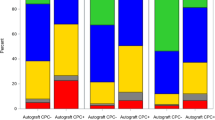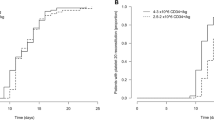Abstract
Purpose
High-dose chemotherapy with hematopoietic stem-cell rescue is increasingly being used in the treatment of multiple myeloma. Bone marrow and also peripheral blood stem-cell (PBSC) grafts contain measurable quantities of plasma cells, the biological significance of which is unknown.
Methods
Patients with multiple myeloma were mobilized with chemotherapy and filgrastim. The number of CD38++/CD138+ cells/kg in the grafts for autologous transplantation was determined by flow cytometry. Patients were stratified into two groups (threshold 4.5×105 plasma cells kg-1) of reinfused plasma cells in the first autologous graft.
Results
The median statistical progression-free survival was 14 months (4–34 months) in the high-contamination group (>4.5×105 plasma cells kg-1) compared to 26 months (4–43 months) in the low-contamination group (<4.5×105 plasma cells kg-1, P =0.0096). Patients with 13q deletion were more frequently found to have a high contamination of the stem-cell graft with malignant plasma cells.
Conclusions
Patients with graft contamination of more than 4.5×105 plasma cells kg-1 had a high risk of early disease progression after high-dose chemotherapy. In vivo tumor cell purging prior to mobilization chemotherapy might be one strategy to improve the time to progression of high-risk patients.



Similar content being viewed by others
References
Attal M, Harousseau JL, Stoppa AM, Sotto JJ, Fuzibet JG, Rossi JF, Casassus P, Maisonneuve H, Facon T, Ifrah N, Payen C, Bataille R (1996) A prospective, randomized trial of autologous bone marrow transplantation and chemotherapy in multiple myeloma. New Engl J Med 335:91–97
Barlogie B, Jagannath S, Vesole DH, Naucke S, Cheson B, Mattox S, Bracy D, Salmon S, Jacobson J, Crowley J, Tricot G (1997) Superiority of tandem autologous transplantation over standard therapy for previously untreated multiple myeloma. Blood 89:789–793
Boccadoro M, Omede P, Dominietto A, Palumbo S, Bringhen S, Giarettea F, Ortolano B, Triolo S, Pileri A (2000) Multiple myeloma: the number of reinfused plasma cells does not influence outcome of patients treated with intensified chemotherapy and PBPC support. Bone Marrow Transplant 25:25–29
Child JA, Morgan GJ, Davies FE, Owen RG, Bell SE, Hawkins K, Brown J, Drayson MT, Selby PJ (2003) High-dose chemotherapy with hematopoietic stem-cell rescue for multiple myeloma. New Engl J Med 348:1875–1883
Einsele H, Bamberg M, Budach W, Schmidberger H, Hess CF, Wormann B, Meisner C, Straka C, Hebart H, Trumper L, Kroger N, Zander AR, Hegewisch-Becker S, Hossfeld DK, Schmidt H, Muller P, Schlimok G, Hertenstein B, Peest D, Metzner B, Frickhofen N, Kanz L, Bensinger WI (2003) A new conditioning regimen involving total marrow irradiation, busulfan and cyclophosphamide followed by autologous PBSCT in patients with advanced multiple myeloma. Bone Marrow Transplant 32:593–599
Gazitt Y, Tian E, Barlogie B, Reading CL, Vesole DH, Jagannath S, Schnell J, Hoffmann R, Tricot G (1996) Differential mobilization of myeloma cells and normal hematopoietic stem cells in multiple myeloma after treatment with cyclophosphamide and granulocyte-macrophage colony-stimulating factor. Blood 87:805–811
Gertz MA, Witzig TE, Pineda AA, Greipp PR, Kyle RA, Litzow MR (1997) Monoclonal plasma cells in the blood stem cell harvest from patients with multiple myeloma are associated with shortened relapse-free survival after transplantation. Bone Marrow Transplant 19:337–342
Henry JM, Sykes PJ, Brisco MJ, To LB, Juttner CA, Morley AA (1996) Comparison of myeloma cell contamination of bone marrow and peripheral blood stem cell harvests. Br J Haematol 92:614–619
Kumar S, Witzig TE, Greipp PR, Rajkumar SV (2003) Bone marrow angiogenesis and circulating plasma cells in multiple myeloma. Br J Haematol. 122:272–274
Lemoli RM, Fortuna A, Motta MR, Rizzi S, Giudice V, Nannetti A, Martinelli G, Cavo M, Amabile M, Mangianti S, Fogli M, Conte R, Tura S (1996) Concomitant mobilization of plasma cells and hematopoietic progenitors into peripheral blood of multiple myloma patients: positive selection and transplantation of enriched CD34+ cells to remove circulating tumor cells. Blood 87:1625–1634
Lemoli RM, Martinelli G, Zamagni E, Motta MR, Rizzi S, Terragna C, Rondelli R, Ronconi S, Curti A, Bonifazi F, Tura S, Cavo M (2000) Engraftment, clinical, and molecular follow-up of patients with multiple myeloma who were reinfused with highly purified CD34+ cells to support single or tandem high-dose chemotherapy. Blood 95:2234–2239
Mariette X, Fermand JP, Brouet JC (1994) Myeloma cell contamination of peripheral blood stem cell grafts in patients with multiple myeloma treated by high-dose therapy. Bone Marrow Transplant 14:47–50
Martinelli G, Terragna C, Lemoli RM, Cavo M, Benni M, Motta MR, Amabile M, Ottaviani E, Testoni N, de Vivo A, Tura S (1999) Clinical and molecular follow-up by amplification of the CDRIII IgH region in multiple myeloma patients after autologous transplantation of hematopoietic CD34+ stem cells. Haematologica 84:397–404
O’Connell N, Gardiner N, Duggan C, Enright H, Kennedy MJ, McCann SR, Daly PA, Browne PV (2001) Effective progenitor cell mobilization in lymphoproliferative disorders using ifosfamide, epirubicin and etoposide (IEV). Eur J Haematol 64 [Suppl]:33–36
Omede P, Tarella C, Palumbo A, Argentino C, Caracciolo D, Corradini P, Dominietto A, Giarettea F, Ravaglia R, Triolo R, Triolo S, Pileri A, Boccadoro M (1997) Multiple myeloma: reduced plasma cell contamination in peripheral blood progenitor cell collections performed after repeated high-dose chemotherapy courses. Br J Haematol 99:685–691
Pardanani A, Witzig TE, Schroeder G, McElroy EA, Fonseca R, Dispenzieri A, Lacy MQ, Lust JA, Kyle RA, Greipp PR, Gertz MA, Rajkumar SV (2003) Circulating peripheral blood plasma cells as a prognostic indicator in patients with primary systemic amyloidosis. Blood 101:827–830
Pilarski LM, Belch AR (2002) Clonotypic myeloma cells able to xenograft myeloma to nonobese diabetic severe combined immunodeficient mice copurify with CD34 (+) hematopoietic progenitors. Clin Cancer Res. 8:3198–3204
Rawstron AC, Davies FE, DasGupta R, Ashcroft AJ, Patmore R, Drayson MT, Owen RG, Jack AS, Child JA, Morgan GJ (2002) Flow cytometric disease monitoring in multiple myeloma: the relationship between normal and neoplastic plasma cells predicts outcome after transplantation. Blood 100:3095–3100
San Miguel JF, Almeida J, Mateo G, Blade J, Lopez-Berges C, Caballero D, Hernandez J, Moro MJ, Fernandez-Calvo J, Diaz-Mediavilla J, Palomera L, Orfao A (2002) Immuno-phenotypic evaluation of the plasma cell compartment in multiple myeloma: a tool for comparing the efficacy of different treatment strategies and predicting outcome. Blood 99:1853–1856
Stewart AK, Vesico R, Schiller G, Ballester O, Noga S, Rugo H, Freytes C, Stadtmauer E, Tarantolo S, Sahebi F, Stiff P, Meharchard J, Schlossman R, Brown R, Tully H, Benyunes M, Jacobs C, Berenson R, White M, DiPersio J, Anderson KC, Berenson J (2001) Purging of autologous peripheral-blood stem cells using CD34 selection does not improve overall or progression-free survival after high-dose chemotherapy for multiple myeloma: results of a multicenter randomized controlled trial. J Clin Oncol 19:3771–3779
Vesico RA, Han EJ, Schiller GJ, Lee JC, Wu CH, Cao J, Shin J, Kim Lichtenstein AK, Berenson JR (1996) Quantitative comparison of multiple myeloma tumor contamination in bone marrow harvest and leukapheresis autografts. Bone Marrow Transplant 18:103–110
Vogel W, Kunert C, Blumenstengel K, Fricke HJ, Kath R, Sayer G, Höffken K (1998) Correlation between granulocyte/macrophage-colony-forming units and CD34+ cells in apheresis products from patients treated with different chemotherapy regimens and granulocyte-colony-stimulating factor to mobilize peripheral blood progenitor cells. J Cancer Res Clin Oncol 124:341–345
Vogel W, Scheding S, Kanz L, Brugger W (2000) Clinical applications of CD34+ peripheral blood progenitor cells (PBPC). Stem Cells 18:87–92
Acknowledgements
The authors gratefully acknowledge Dr. Peter Liebisch, University of Ulm, Germany, for performing cytogenetic analysis using FISH technology and the excellent technical assistance of Ms. Anja Weber, Ms. Verena Mauch and Ms. Susanne Schneider.
Author information
Authors and Affiliations
Corresponding author
Rights and permissions
About this article
Cite this article
Vogel, W., Kopp, HG., Kanz, L. et al. Myeloma cell contamination of peripheral blood stem-cell grafts can predict the outcome in multiple myeloma patients after high-dose chemotherapy and autologous stem-cell transplantation. J Cancer Res Clin Oncol 131, 214–218 (2005). https://doi.org/10.1007/s00432-004-0635-y
Received:
Accepted:
Published:
Issue Date:
DOI: https://doi.org/10.1007/s00432-004-0635-y




